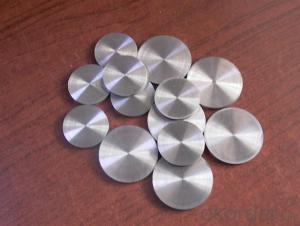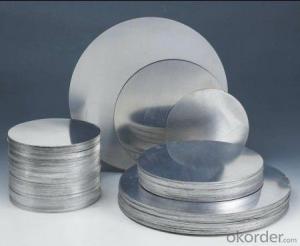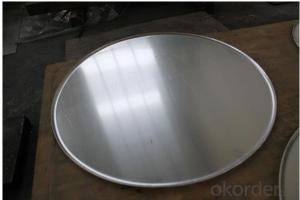Aluminium Circle for Cookware spinning AA3003
- Loading Port:
- Shanghai
- Payment Terms:
- TT OR LC
- Min Order Qty:
- 2 m.t.
- Supply Capability:
- 2000 m.t./month
OKorder Service Pledge
OKorder Financial Service
You Might Also Like
Item specifice
1.Structure of Spinning Aluminium Circle
Aluminium Circle is one semi-finished aluminium material. Aluminium Circle is widly used cookware, for example, aluminium pot, aluminium pan, aluminium cup ect. Our aluminium circle are widly exported to African market. We export more than 2000 tons every month. We can assure the breakage rate below 5%. Extra breakage will be responsible by our company.
2. Main features of Spinning Aluminium Circle
a.Competitive price---We have our own mills and can produce mill finished aluminium coils, so we can control the production cost better.
b.Professional after-sale service---We have more than 15 years exportation experience and you need not worry about the exporation problems.
c.Fast delivery time---We can control the delivery time within 35 days.
3. Image
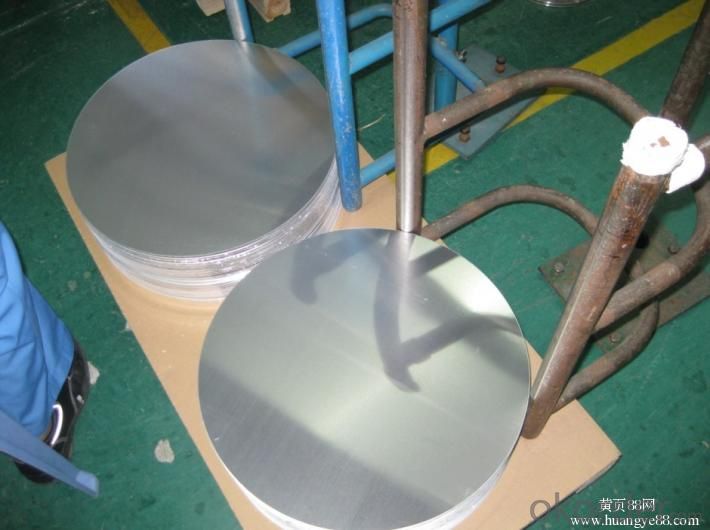

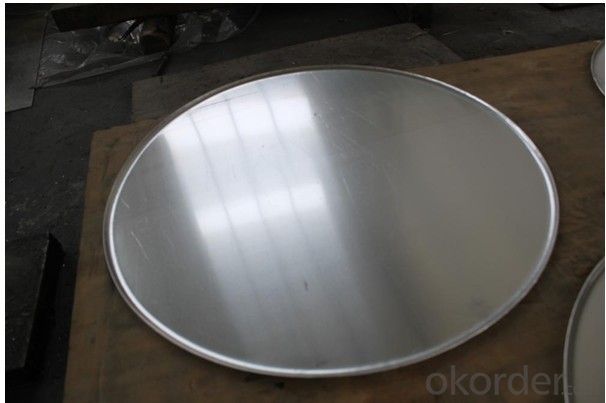
4. Product Specification
| Alloy | Thickness | Diameter | Weight | Style |
| AA3003 | 0.2MM-2MM | 100MM-1000MM | 2 TONS | Spinning |
5.FAQ:
What is the quality standard?
---Usually our standard is GB3880-2006
What is the largest width?
---It is 2300mm
What is the MOQ?
---Usually we can accept 2 tons.
- Q:Can aluminum sheets be painted after installation?
- After installation, it is indeed possible to paint aluminum sheets. Aluminum, being a highly versatile and durable material, can be painted for the purpose of improving its appearance or harmonizing it with the surrounding environment. However, it is crucial to adequately prepare the surface before painting in order to ensure that the paint adheres well and lasts long. This typically involves cleaning the surface, eliminating any dirt or debris, and applying a suitable primer to enhance paint adhesion. Once the surface is prepared, various types of paint can be used on the aluminum sheet, such as acrylic, oil-based, or epoxy paint. To achieve the best results, it is advisable to seek guidance from a professional painter or carefully follow the instructions provided by the paint manufacturer.
- Q:The minimum thickness of aluminum curtain wall is 2, 5mm or 3mm?
- The veneer is 2.5 mm, and the composite plate needs to be explored
- Q:What is the electrical conductivity of aluminum sheets?
- The electrical conductivity of aluminum sheets is quite high, as aluminum is known to be an excellent conductor of electricity.
- Q:Are aluminum sheets resistant to staining?
- Yes, aluminum sheets are generally resistant to staining due to their natural ability to form a protective oxide layer on the surface, which prevents corrosion and staining.
- Q:What is the width and length of the aluminum sheets?
- The width and length of the aluminum sheets can vary depending on the specific product or manufacturer. It would be best to consult the product specifications or contact the manufacturer for accurate measurements.
- Q:Where is the difference between the 5052 aluminum plate and the 1060 Aluminum plate?
- Ingredients:5052 alloy aluminum (aluminum magnesium alloy, aluminum content of about 95%, magnesium content of about 4%, as well as some other trace metal elements)1060 is pure aluminum (aluminum containing 99.6%, margin for other metal elements)Physical property:Similarly, the two kinds of aluminum, 5052 to 1060 higher in hardness, elongation, tensile strength and so on are not the same. What are the specific states (H14, H32, H24, O, etc.)?Prices are usually 5052 above 1060. How much specific higher, according to different manufacturers and production processes vary.
- Q:Are aluminum sheets suitable for food packaging?
- Yes, aluminum sheets are suitable for food packaging. Aluminum is a highly versatile and widely used material in the food industry due to its unique properties. It is lightweight, flexible, and has excellent barrier properties that protect the contents from external factors such as moisture, light, and oxygen. These properties help to maintain the freshness and quality of food products. Additionally, aluminum is resistant to corrosion and does not react with acidic or alkaline substances, ensuring that the taste and quality of the food is preserved. Furthermore, aluminum sheets can be easily shaped into different forms, making them ideal for various types of food packaging such as trays, containers, and foil wraps. Overall, aluminum sheets are a safe and effective choice for food packaging, providing durability, protection, and convenience.
- Q:What are the different grades of aluminum sheets?
- In the market, a variety of aluminum sheet grades can be found, each having its own unique properties and uses. Some commonly used grades are 3003, 5052, and 6061. Grade 3003, a non-heat treatable alloy, displays high resistance against corrosion. It finds its application in scenarios where corrosion resistance is crucial, such as packaging, cooking utensils, and chemical equipment. Grade 5052, also non-heat treatable, offers exceptional corrosion resistance along with strength and durability. This makes it suitable for marine applications, transportation equipment, and architectural purposes. Grade 6061, a heat treatable alloy, combines good corrosion resistance with high strength. It is extensively used in structural applications like aircraft components, automotive parts, and construction materials. In addition to these grades, there are specialized aluminum alloys like 2024, 7075, and 5083, catering to specific properties required in particular industries or applications. To ensure the right grade of aluminum sheet for your project, it is crucial to consider its specific requirements, as each grade possesses its own strengths and limitations. Seeking advice from a knowledgeable supplier or expert can assist in determining the most suitable grade for your needs.
- Q:I think I remember that this is true of aluminum foil. When it's charged, it'll push away from itself, I know. Why do magnets have seemingly no effect?
- Aluminum is a non-ferrous metal. Ferrous metals contain Iron which is magnetic. When aluminum has a charge applied to it, it acts like any conductor would, the charge has magnetic properties. the aluminum is still not magnetic, but it acts like a magnet due to the charge.
- Q:How do you prevent distortion of aluminum sheets during welding?
- To prevent distortion of aluminum sheets during welding, there are several key measures that can be taken: 1. Proper joint preparation: Ensuring that the edges of the aluminum sheets are properly cleaned and beveled before welding is crucial. This helps in achieving a better fit-up and minimizes the chances of distortion. 2. Fixture and clamping: Using appropriate fixtures and clamps to hold the aluminum sheets in place during welding can help to restrain and distribute the heat more evenly. This helps in reducing the risk of distortion by preventing the sheets from moving or buckling due to thermal expansion. 3. Tack welding: Prior to performing a full weld, tack welding can be done at regular intervals along the joint. This helps in temporarily fixing the sheets in place and distributing the heat, allowing for more controlled cooling and minimizing distortion. 4. Welding sequence: Applying a proper welding sequence can also help in preventing distortion. It is recommended to start welding from the center and gradually move towards the edges, alternating between sides. This helps in balancing the heat input and minimizing distortion by allowing the welded sections to cool down before the next weld is performed. 5. Preheating and post-weld heat treatment: For thicker aluminum sheets, preheating the material before welding can help to reduce the temperature gradient and minimize distortion. Additionally, post-weld heat treatment can be applied to relieve residual stresses and promote dimensional stability. 6. Welding technique: Employing appropriate welding techniques such as using a lower heat input and slower travel speed can help in minimizing distortion. Additionally, using a smaller weld bead size and avoiding excessive weaving can also help to control the heat input and reduce the chances of distortion. 7. Proper weld parameters: Ensuring that the welding parameters such as voltage, current, and wire feed speed are properly set and maintained is crucial. Using the correct parameters for the specific aluminum alloy being welded can help to achieve a more controlled heat input, minimizing distortion. By implementing these preventive measures, the risk of distortion during aluminum sheet welding can be significantly reduced, resulting in improved weld quality and dimensional stability.
1. Manufacturer Overview |
|
|---|---|
| Location | |
| Year Established | |
| Annual Output Value | |
| Main Markets | |
| Company Certifications | |
2. Manufacturer Certificates |
|
|---|---|
| a) Certification Name | |
| Range | |
| Reference | |
| Validity Period | |
3. Manufacturer Capability |
|
|---|---|
| a)Trade Capacity | |
| Nearest Port | |
| Export Percentage | |
| No.of Employees in Trade Department | |
| Language Spoken: | |
| b)Factory Information | |
| Factory Size: | |
| No. of Production Lines | |
| Contract Manufacturing | |
| Product Price Range | |
Send your message to us
Aluminium Circle for Cookware spinning AA3003
- Loading Port:
- Shanghai
- Payment Terms:
- TT OR LC
- Min Order Qty:
- 2 m.t.
- Supply Capability:
- 2000 m.t./month
OKorder Service Pledge
OKorder Financial Service
Similar products
New products
Hot products
Related keywords
